Enhancing CO2 Injection Efficiency: Rock-Breaking Characteristics of Particle Jet Impact in Bottom Hole
Abstract
1. Introduction
2. Methods
2.1. Finite Element Model
2.1.1. SPH-FEM Model
2.1.2. Water and Rock Damage Model
2.1.3. Finite Element Model Description
2.2. Experimental
2.2.1. Experimental Setup
2.2.2. Materials
2.3. Theoretical Model Validation
3. Results and Discussion
3.1. Analysis of the Rock-Breaking Process
3.2. Effects of Particle Jet Parameters
3.2.1. Jet Inlet Velocity
3.2.2. Particle Diameter
3.2.3. Particle Concentration
3.2.4. Confining Pressure
3.2.5. Temperature
4. Conclusions
Author Contributions
Funding
Institutional Review Board Statement
Informed Consent Statement
Data Availability Statement
Acknowledgments
Conflicts of Interest
Nomenclature
| Nomenclature | ||
| a | volume correction | - |
| A | characteristic bonding strength parameter | - |
| B | characteristic pressure hardening index | - |
| C | strain rate effect coefficient | - |
| Cb | normalization constant | - |
| mixing efficiency coefficient | - | |
| Cp | particle volume concentrations | % |
| CMG | curve intercept | m/s |
| D | damage ratio | - |
| E | internal energy per unit volume | - |
| Ep | elasticity modulus of particles | |
| h | SPH particle smooth length | - |
| mg | gas mass flow rate | kg/s |
| mp | particle mass flow rate | kg/s |
| mw | water mass flow rate | kg/s |
| N | pressure hardening index | - |
| Pc | confining pressure | MPa |
| nozzle pressure | MPa | |
| pressure | MPa | |
| dimensionless hydrostatic pressure | - | |
| S1, S2, and S3 | curve slope coefficient | - |
| jet inlet velocity | m/s | |
| Ti | temperature | °C |
| Greek letters | ||
| MIE-GRUNEISEN constant | - | |
| strain rate with a dimension of 1 | - | |
| density | g/cm3 | |
| particle density | g/cm3 | |
| equivalent stress pressure | - | |
| υp | Poisson’s ratio of particles | |
| Ω | support domain of the point x | - |
References
- Cui, Y.N.; Bai, J.J.; Liao, S.L.; Cao, S.J.; Liu, F.Z. Suggestions on the development of environmental monitoring technology of CO2 geological storage and leakage under the background of China’s “Double-Carbon” strategy. Atmosphere 2023, 14, 51. [Google Scholar] [CrossRef]
- Rui, J. Progress of CO2 sequestration technique application in oil and gas industry. Pet. Petrochem. Today 2022, 30, 34–37. [Google Scholar]
- Li, X.Y.; Gao, X.; Xie, J.J. Comparison and clarification of china and US CCUS technology development. Atmosphere 2022, 13, 2114. [Google Scholar] [CrossRef]
- Ban, F.S.; Xiao, L.Z.; Yuan, G.J.; Yang, C.L. Rapid solution mining technology for underground gas storage in salt caverns and case histories. Nat. Gas Ind. 2012, 32, 77–79. [Google Scholar]
- Momber, A.W.; Kovacevic, R. Deformation and fracture of rocks loaded with spherical indenters. Int. J. Fract. 2004, 125, 206–279. [Google Scholar] [CrossRef]
- Momber, A.W. A refined model for solid particle rock erosion. Rock Mech. Rock Eng. 2016, 49, 464–475. [Google Scholar] [CrossRef]
- Sahu, J.N.; Sasikumar, C. Room temperature Case Carburizing of a Ni–Cr–Mo Steel Through Shot Peening/Blasting Techniques. Trans. Indian Inst. Met. 2015, 68, 227–233. [Google Scholar] [CrossRef]
- Zhao, J.; Sun, B.J.; Chang, F.R.; Han, X.Q.; Ning, Q.; Xu, Y.J. Cement erosion process with recyclable sand particle water-jet impacts. J. Clean. Prod. 2021, 292, 126006. [Google Scholar] [CrossRef]
- Szesz, E.M.; Pereira, B.L.; Kuromoto, N.K. Electrochemical and morphological analyses on the titanium surface modified by shot blasting and anodic oxidation processe. Thin Solid Film. 2013, 528, 163–166. [Google Scholar] [CrossRef]
- Tibbtitts, G.A.; Galloway, G.G. Particle drilling alters standard rock-cutting approach. World Oil 2008, 229, 37–44. [Google Scholar]
- Tibbtitts, G.A.; Galloway, G.G.; Terry, J.B. Impactor Excavation System Having a Drill Bit Discharging in a Cross over Pattern. U.S. Patent 8845279B2, 16 July 2013. [Google Scholar]
- Galloway, G.G. Shot Blocking Using Drilling Mud. U.S. Patent 8342256B2, 1 January 2013. [Google Scholar]
- Zhao, J.; Zhang, G.C.; Xu, Y.J.; Wang, R.H.; Zhou, W.D. Mechanism and effect of jet parameters on particle waterjet rock breaking. Powder Technol. 2017, 313, 231–244. [Google Scholar] [CrossRef]
- Momber, A.W. Wear of rocks by water flow. Int. J. Rock Mech. Min. 2004, 41, 51–68. [Google Scholar] [CrossRef]
- Ren, F.S.; Fang, T.C.; Cheng, X.Z.; Cheng, J.X. Failure volume under particle water-jet impact in deep well drilling engineering: Mathematical modeling and verification analysis. Alex. Eng. J. 2021, 60, 1839–1849. [Google Scholar] [CrossRef]
- Zeng, J.; Kim, T.J. A erosion model of polycrystalline ceramics in abrasive waterjet cutting. Wear 1996, 193, 207–217. [Google Scholar] [CrossRef]
- Li, G.S.; Huang, Z.W.; Niu, J.L. The productivity-enhancing technique of deep penetrating perforation with a high-pressure water jet. Pet. Sci. Technol. 2007, 25, 289–297. [Google Scholar]
- Xu, Y.Q.; Li, F.X.; Li, Q.D. Numerical simulation method and structural optimization for shearing capacity of ram blowout preventers. Geoenergy Sci. Eng. 2024, 233, 212559. [Google Scholar] [CrossRef]
- Huang, C.K.; Chinvelli, S.; Minev, P. A comprehensive phenomenological model for erosion of materials in jet flow. Powder Technol. 2008, 187, 273–279. [Google Scholar] [CrossRef]
- Finnie, I. Erosion of surfaces by solid particles. Wear 1960, 3, 87–103. [Google Scholar] [CrossRef]
- Xu, Y.Q.; Wang, Y.C.; Tian, Y. Experimental study on ultrasonic wave propagation characteristics of gas-liquid two-phase flow in riser annulus. Appl. Ocean Res. 2023, 141, 103771. [Google Scholar]
- Tae-Min, O.; Gye-Chun, C. Characterization of effective parameters in abrasive water jet rock cutting. Rock Mech. Rock Eng. 2014, 47, 745–756. [Google Scholar]
- Petrica, M.; Badisch, E.; Peinsitt, T. Abrasive wear mechanisms and their relation to rock properties. Wear 2013, 308, 86–94. [Google Scholar] [CrossRef]
- Momber, A.W. Effects of target material properties on solid particle erosion of geomaterials at different impingement velocities. Wear 2015, 319, 69–83. [Google Scholar] [CrossRef]
- Momber, A.W. Erosion of schist due to solid particle impingement. Rock Mech. Rock Eng. 2013, 46, 849–857. [Google Scholar] [CrossRef]
- Peng, C.; Tian, S.C.; Li, G.S.; Sukop, M.C. Simulation of laser-produced single cavitation bubbles with hybrid thermal Lattice Boltzmann method. Int. J. Heat Mass Transf. 2020, 149, 119136. [Google Scholar] [CrossRef]
- Lausch, M.; Reitter, L.M.; Schremb, M.; Hussong, J. Impact of an ice particle onto a rigid substrate: Statistical analysis of the fragment size distribution. Int. J. Impact Eng. 2023, 181, 104732. [Google Scholar] [CrossRef]
- Sun, H.F.; Huang, L.; Long, J.B.; Ruan, F. CFD-DEM coupled calculation of wall wear characteristics during particles flow impacting the wall process. Powder Tech. 2023, 426, 118684. [Google Scholar] [CrossRef]
- Han, S.P.; Sun, Z.W.; Tian, Z.F.; Chinnici, A.; Lau, T.; Troiano, M.; Solimene, R.; Salatino, P.; Nathan, G.J. Experimental study of a dense stream of particles impacting on an inclined surface. Powder Tech. 2024, 438, 119658. [Google Scholar] [CrossRef]
- Zhou, Y.; Lv, W.J.; Zhang, C.; Zhou, Z.H.; Wang, H.Y.; Liang, Q.Y.; Tang, Q.Q.; Han, G.S.; Guo, W.; Zhao, D.J. Novel hard rock breaking technique using ultra-high-frequency particle impact induced by ultrasonic vibration field. Energy 2024, 288, 129747. [Google Scholar] [CrossRef]
- Song, G.Y.; Hogan, C.J. Crystal grain size effects and crystallinity dynamics during supersonic particle impacts. Int. J. Plast. 2023, 170, 103758. [Google Scholar] [CrossRef]
- Peng, D.; Wang, L.G.; Lin, Y.Q.; Zhu, C.Q.; Chen, X.Z.; Liu, Z.H.; Ge, R.H. Oblique impact breakage unification of nonspherical particles using discrete element method. Particuology 2024, 90, 61–71. [Google Scholar] [CrossRef]
- Hadavi, V.; Papini, M. Numerical modeling of particle embedment during solid particle erosion of ductile materials. Wear 2015, 342, 310–321. [Google Scholar] [CrossRef]
- Goodin, C.; Priddy, J.D. Comparison of SPH simulations and cone index tests for cohesive soils. J. Terra. Mech. 2016, 66, 49–57. [Google Scholar] [CrossRef]
- Aktay, L.; Johnson, A.F.; Toksoy, A.K. Modeling the progressive axial crushing of foam-filled aluminum tubes using smooth particle hydrodynamics and coupled finite element model/smooth particle hydrodynamics. Mater. Design 2008, 29, 569–575. [Google Scholar] [CrossRef]
- Zhao, J.; Liao, H.L.; Xu, Y.J.; Shi, F.X.; Sun, B.J.; Chang, F.R.; Han, X.Q. Experimental and theoretical evaluation of tubing cutting with rotating particle jet in oil and gas borehole operation. Energy 2023, 282, 128468. [Google Scholar] [CrossRef]
- Bielawski, M.; Beres, W. FE modelling of surface stresses in erosion-resistant coatings under single particle impact. Wear 2007, 262, 167–175. [Google Scholar] [CrossRef]
- Sun, Z.H. Dynamics Response Analysis of Penetration Based on FE-SPH Adaptive Coupling Method; The Hunan University Press: Changsha, China, 2012. [Google Scholar]
- Lin, X.D.; Lu, Y.Y.; Tang, J.R. Numerical simulation of abrasive water jet breaking rock with SPH-FEM coupling algorithm. J. Vib. Shock 2014, 33, 170–175. [Google Scholar]
- Kong, X.Z.; Fang, Q.; Wu, H. Numerical predictions of cratering and scabbing in concrete slabs subjected to projectile impact using a modified version of HJC material model. Int. J. Impact Eng. 2016, 95, 61–71. [Google Scholar] [CrossRef]
- Lu, B.; Wu, X.T. Finite element simulation of sandstone SHPB experiment under impact load. J. Hefei Univ. Tech. 2022, 45, 1517–1521. [Google Scholar]
- Papini, M.; Ciampini, D.; Krajac, T. Computer modelling of interference effects in erosion testing: Effect of plume shape. Wear 2003, 255, 85–97. [Google Scholar] [CrossRef]
- Shen, Y.F.; Xu, S.; Feng, P.Y.; Pang, F.L. Numerical simulation of rock damage mechanism by water jet under confining pressure. Saf. Coal Mines 2022, 53, 59–65. [Google Scholar]
- Song, J.C.; Wang, Z.J.; Li, Y. Research on granite cutting and breaking test under conditions of high temperature and high pressure. Chi. J. Rock Mech. Eng. 2009, 28, 1422–1438. [Google Scholar]
- Chen, C.J.; Zhu, Y.; Li, Z.P.; Zhang, H.D.; Liu, Y. Energy criterion of coal breaking by abrasive jets based on stress wave effect. J. China Coal Soc. 2022, 47, 3320–3327. [Google Scholar]
- Huppert, H.E.; Neufeld, J.A. The fluid mechanics of carbon dioxide sequestration. Annu. Rev. Med. 2014, 46, 255–272. [Google Scholar] [CrossRef]
- Munkejord, S.T.; Bernstone, C.; Clausen, S.; Koeijer, G.D.; Mølnvik, M.J. Combining thermodynamic and fluid flow modelling for CO2 flow assurance. Energy Procedia 2013, 37, 2904–2913. [Google Scholar] [CrossRef]
- Labzovskii, L.D.; Mak, H.W.L.; Kenea, S.T.; Rhee, J.S.; Lashkari, A.; Li, S.L.; Goo, T.Y.; Oh, Y.S.; Byun, Y.H. What can we learn about effectiveness of carbon reduction policies from interannual variability of fossil fuel CO2 emissions in East Asia? Environ. Sci. Policy 2019, 96, 132–140. [Google Scholar] [CrossRef]
- Sohn, B.J.; Yeh, S.W.; Lee, A.; Lau, W.K.M. Regulation of atmospheric circulation controlling the tropical Pacific precipitation change in response to CO2 increases. Nat. Commun. 2019, 10, 1108. [Google Scholar] [CrossRef]
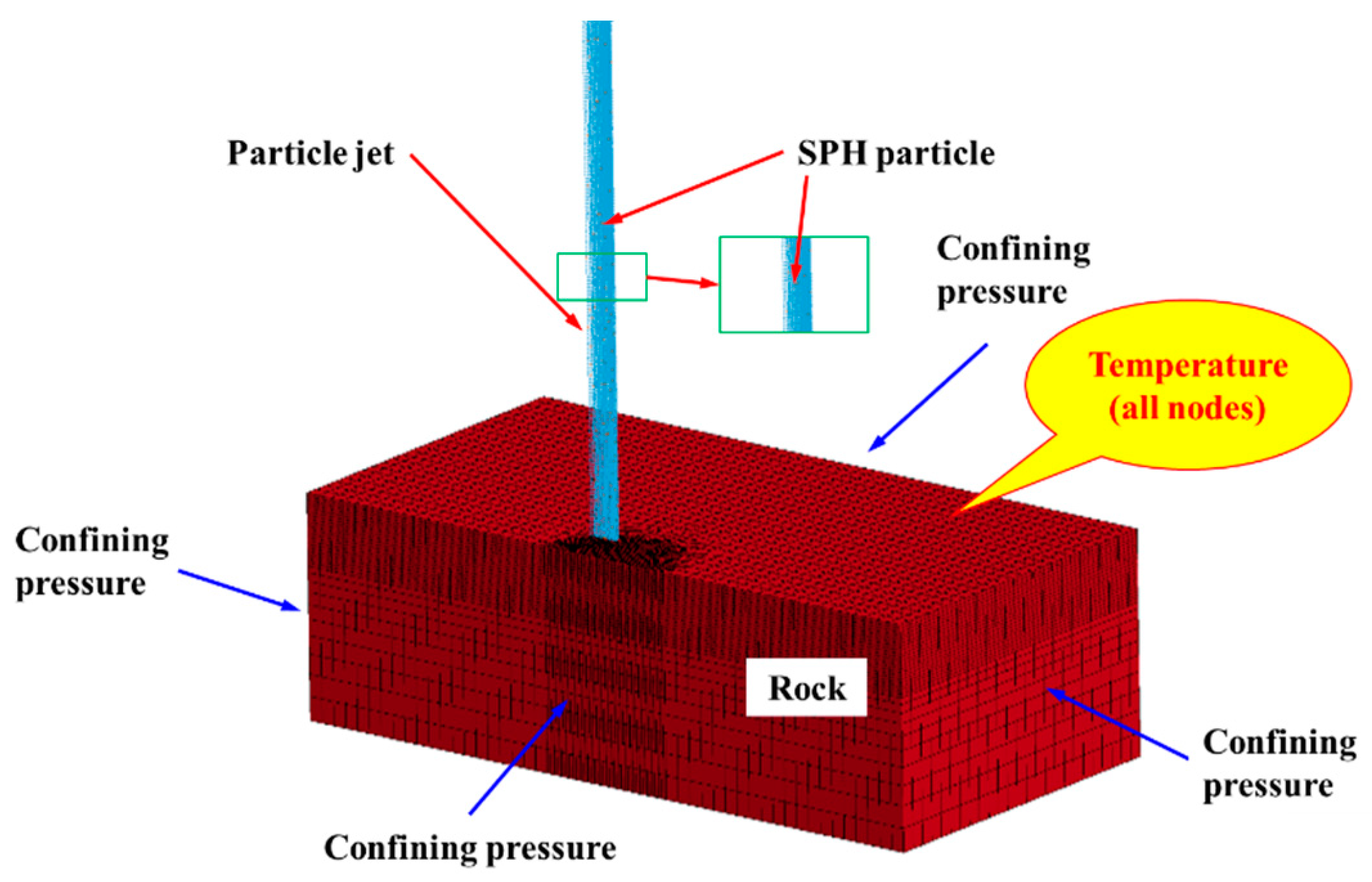
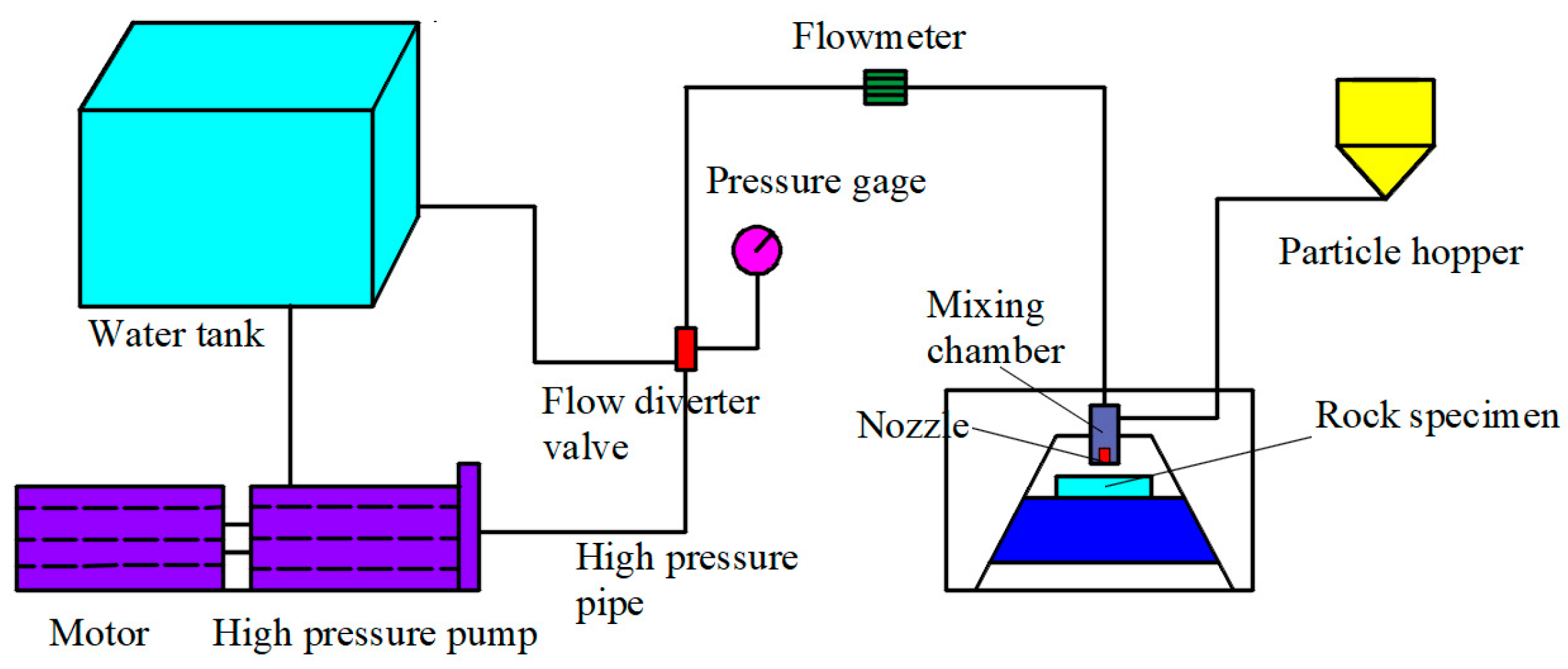

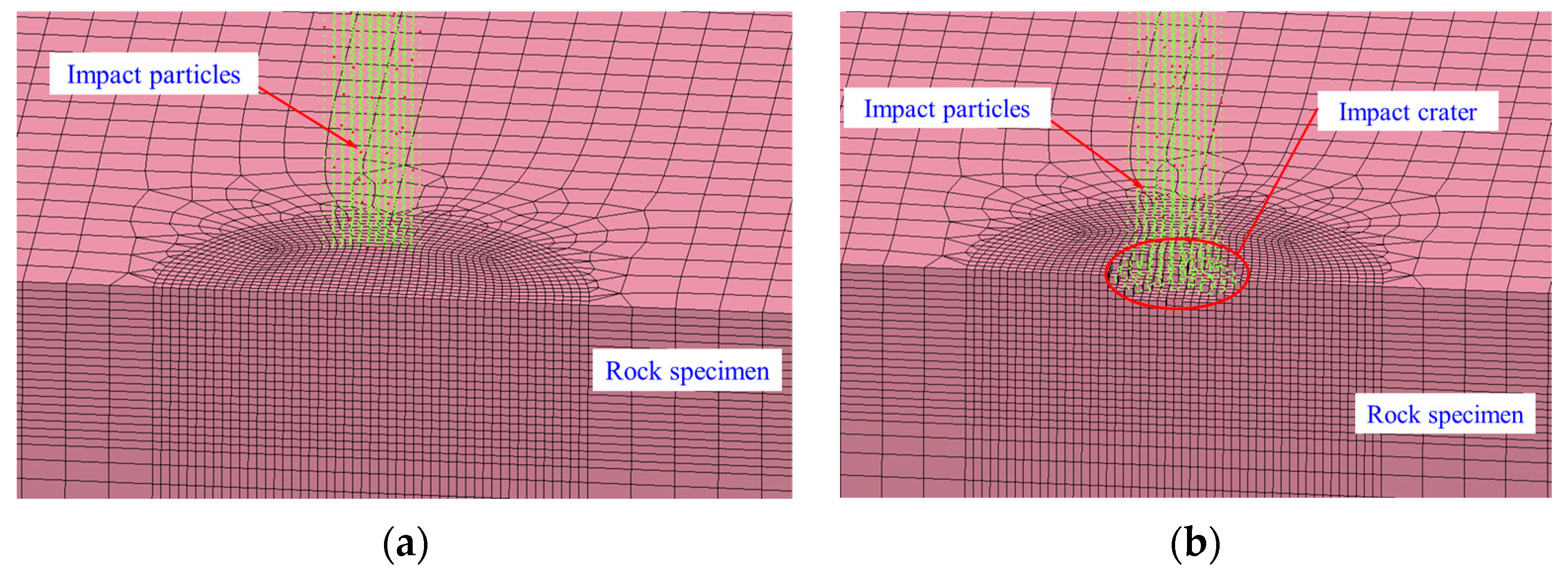
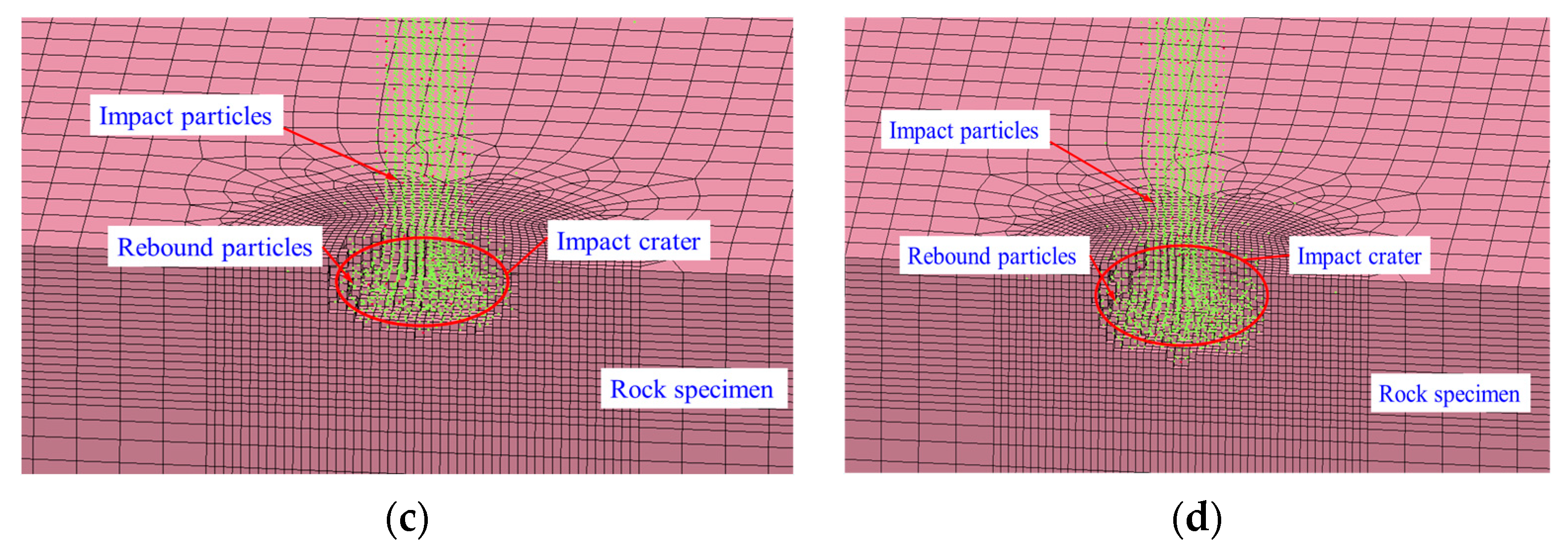
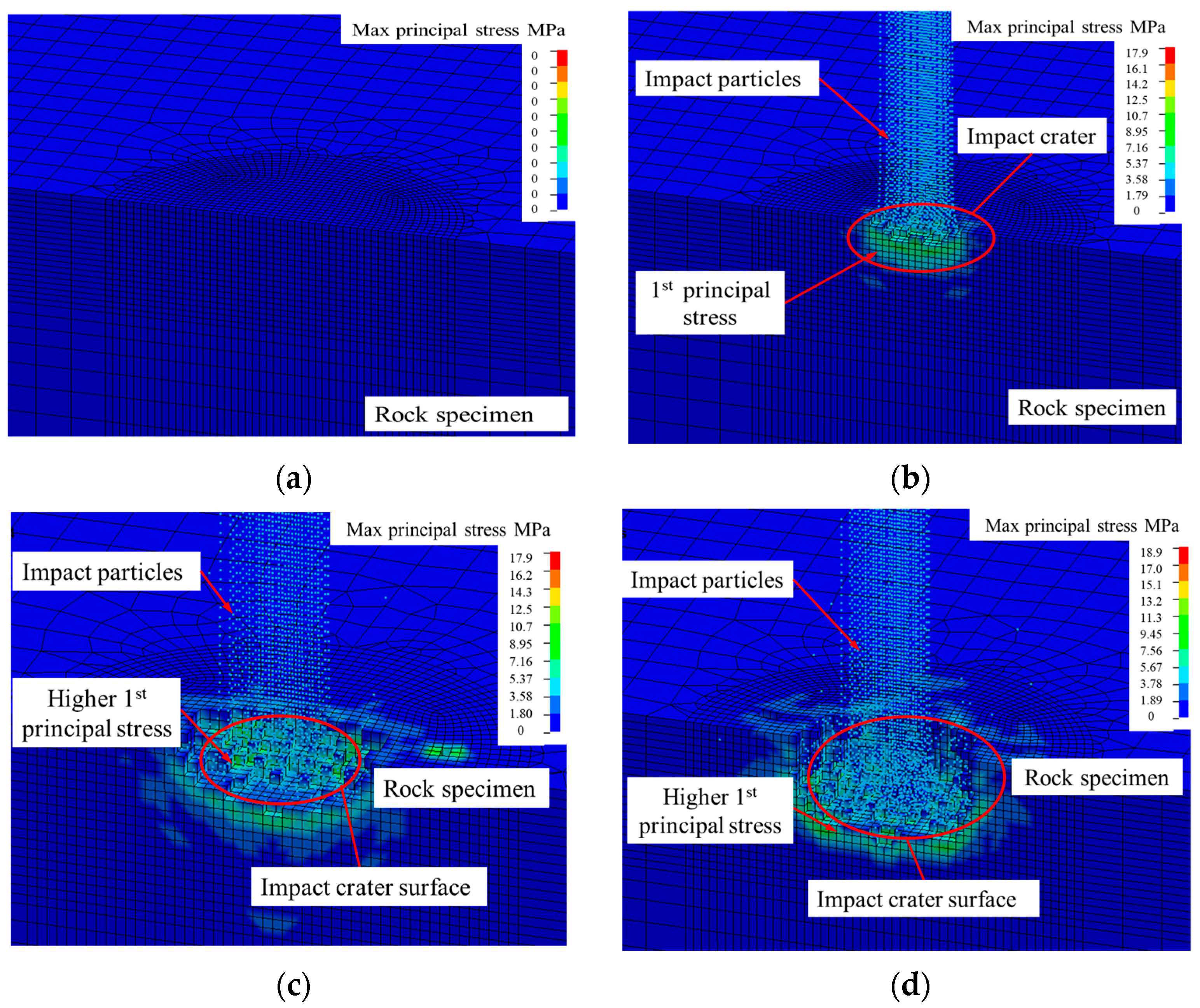
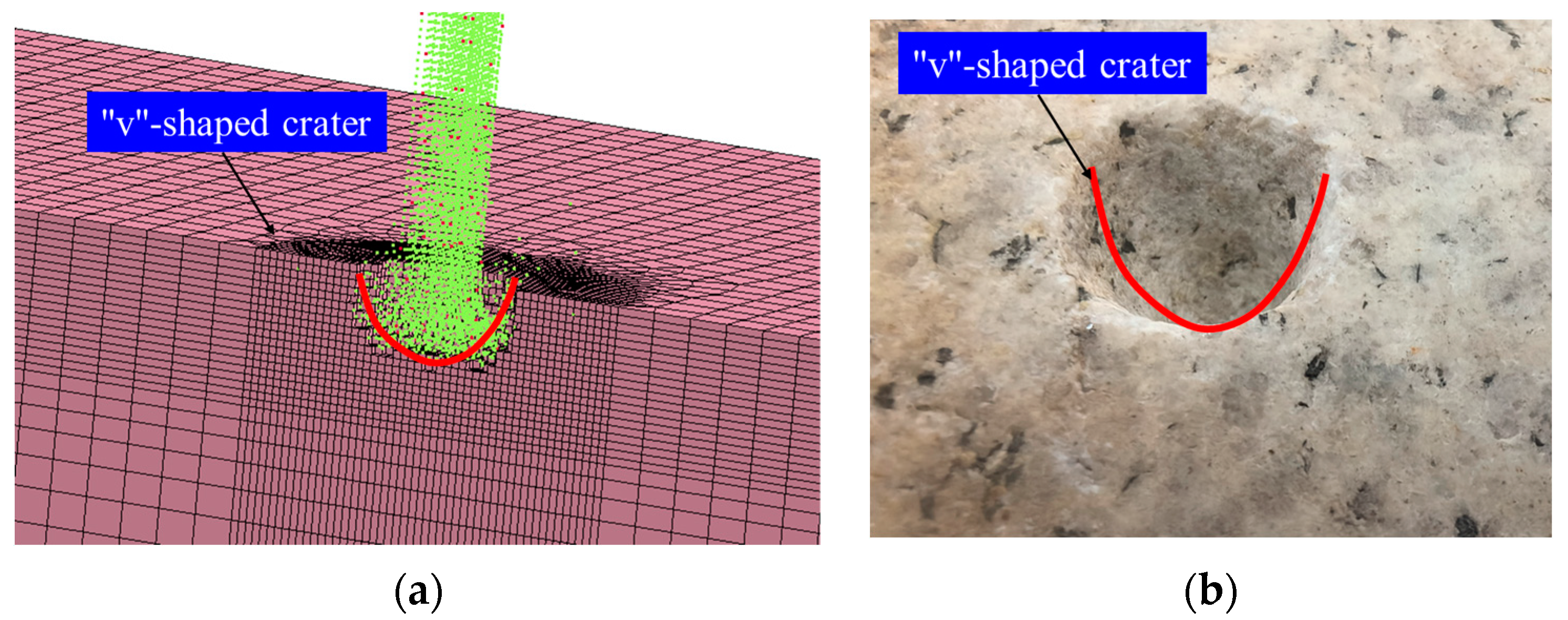
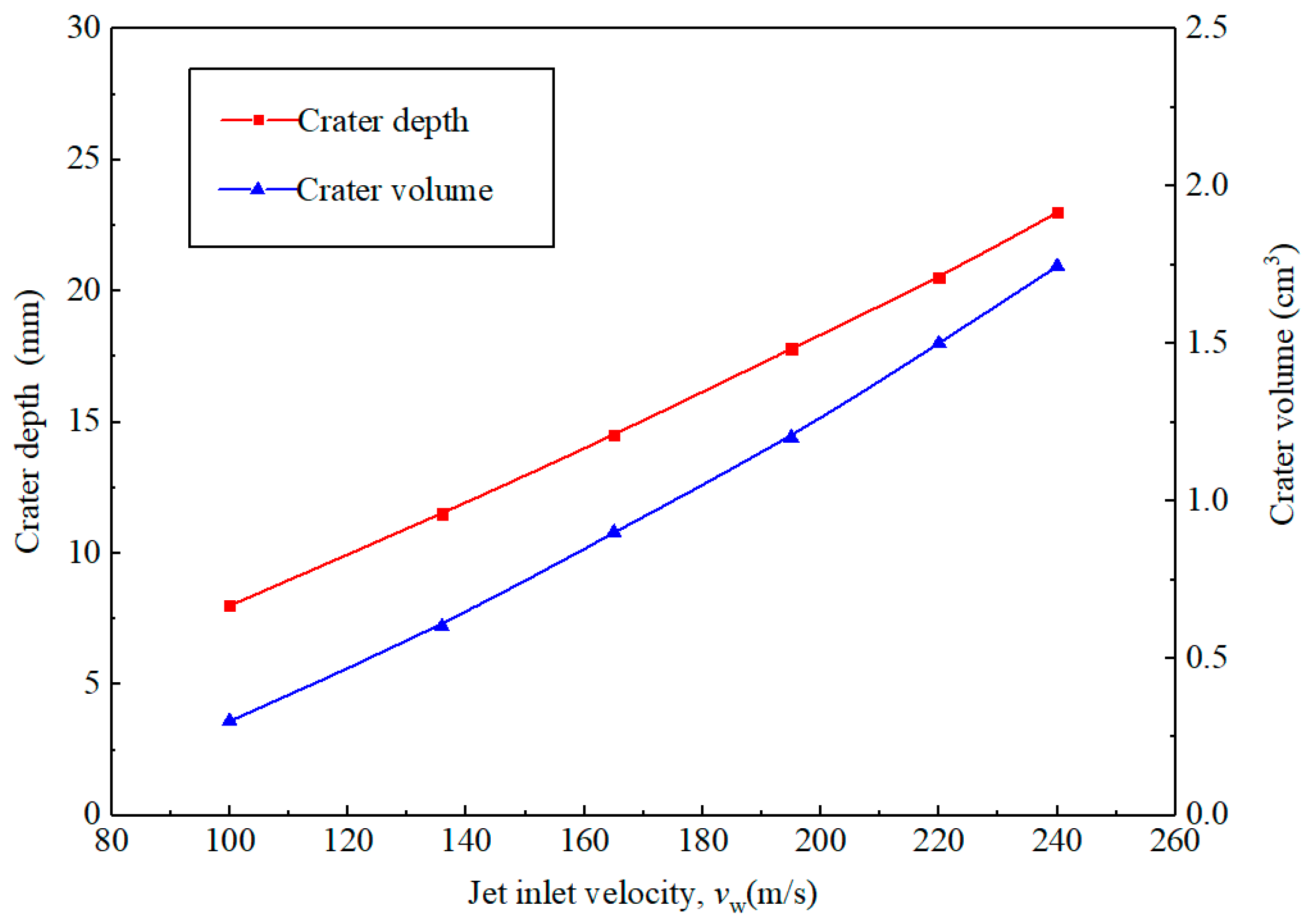
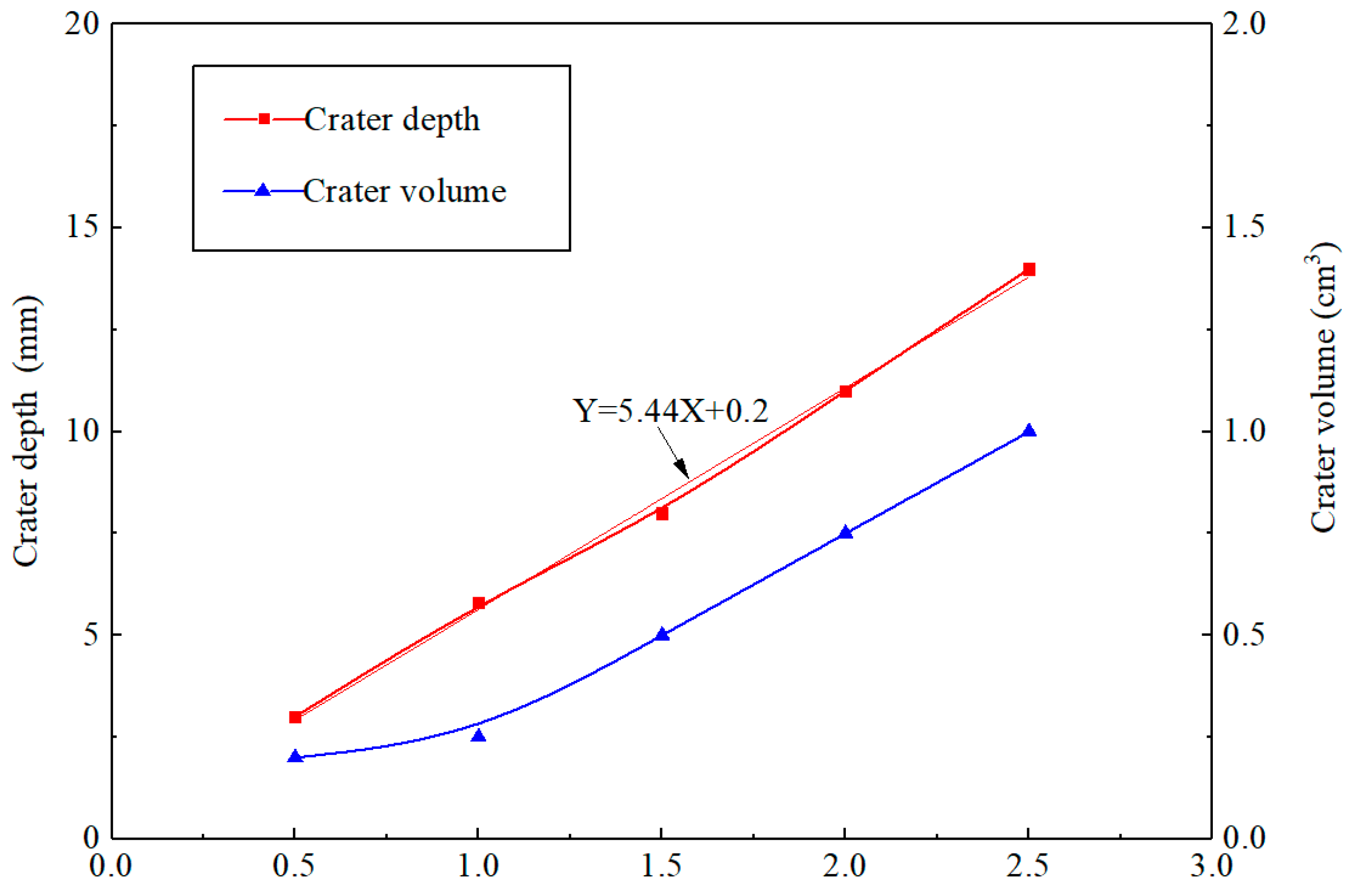


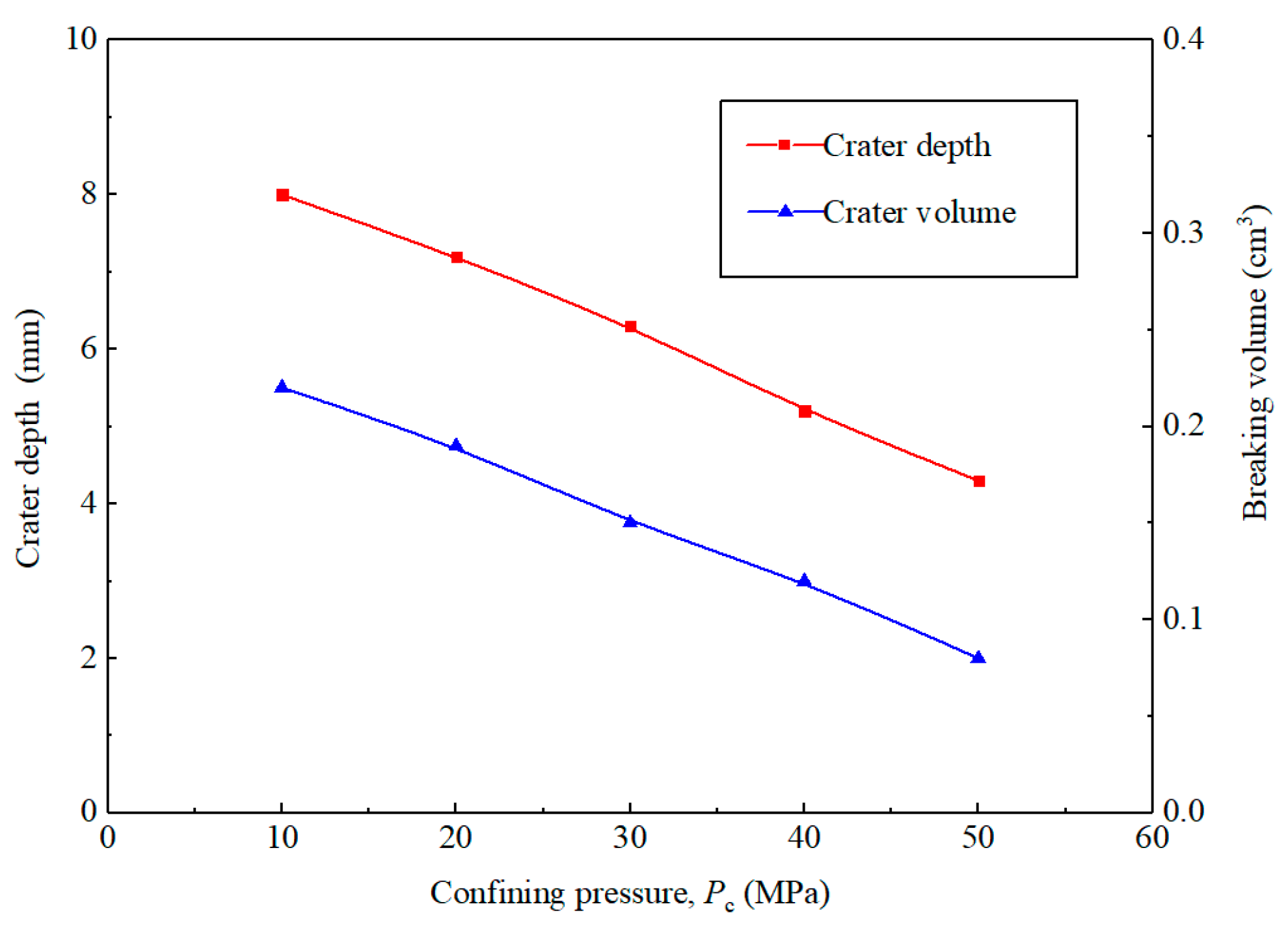
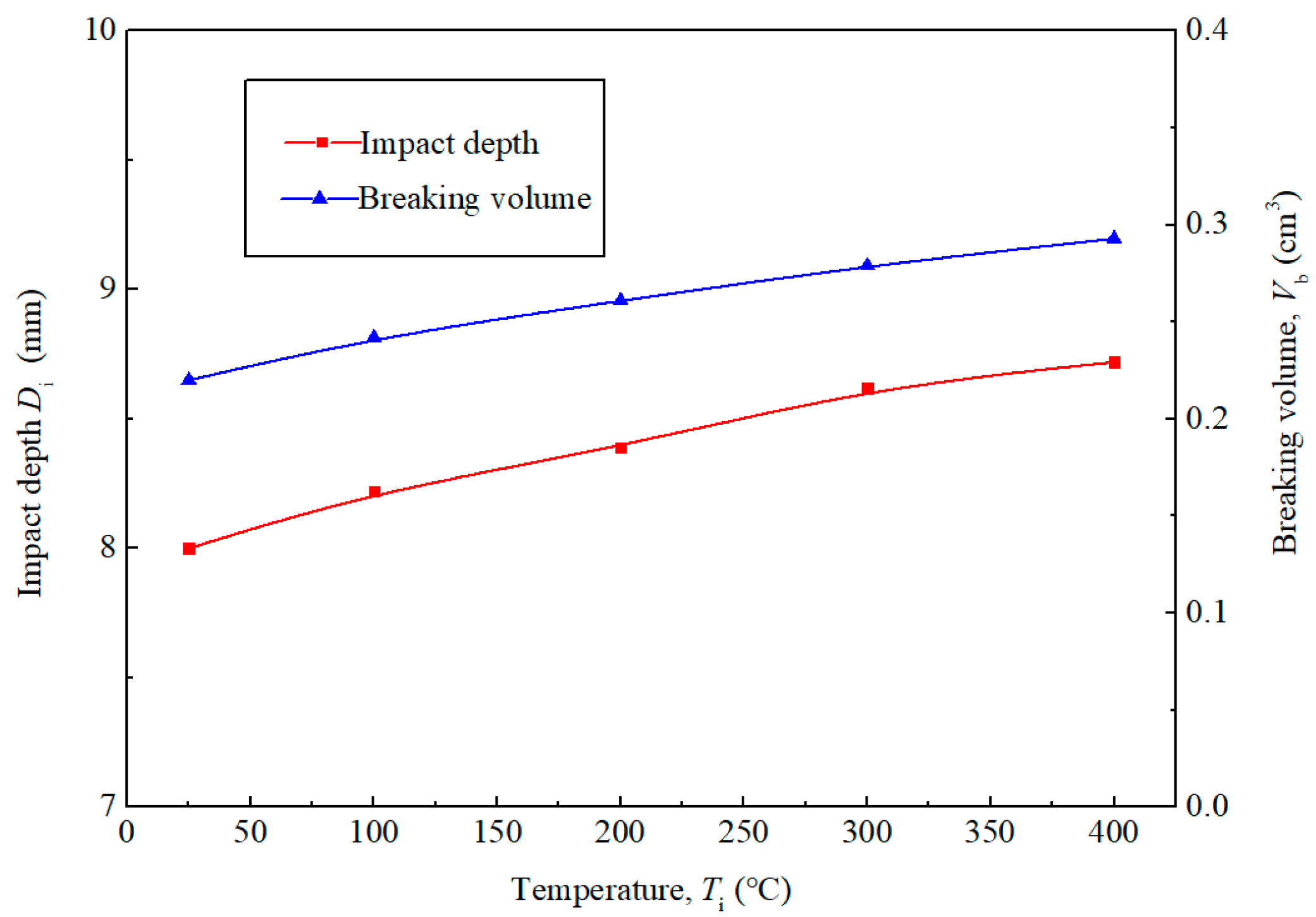
| Material | [g/cm3] | Ep [GPa] | |
|---|---|---|---|
| Particle | 7800 | 0.3 | 210 |
| Material | [g/cm3] | C [m/s] | |||||
|---|---|---|---|---|---|---|---|
| Water | 1 | 1480 | 2.56 | −1.986 | 0.2286 | 1.397 | 0.49 |
| ρ [kg/m3] | G [GPa] | [MPa] | A | B | C | N | |||
|---|---|---|---|---|---|---|---|---|---|
| 2341 | 6.3 | 47.9 | 0.79 | 1.40 | 0.007 | 0.51 | 7.0 | 0.04 | 1.0 |
| T [MPa] | [MPa] | [GPa] | [MPa] | [MPa] | [MPa] | ||||
| 0.01 | 4.3 | 16 | 0.0019 | 0.81 | 0.1 | 85 | −171 | 210 | 1 |
| Parameters | Experiment | Simulation | Deviation |
|---|---|---|---|
| Crater depth [mm] | 5.5 | 5.7 | 3.6% |
| Crater volume [cm3] | 0.240 | 0.252 | 5% |
Disclaimer/Publisher’s Note: The statements, opinions and data contained in all publications are solely those of the individual author(s) and contributor(s) and not of MDPI and/or the editor(s). MDPI and/or the editor(s) disclaim responsibility for any injury to people or property resulting from any ideas, methods, instructions or products referred to in the content. |
© 2024 by the authors. Licensee MDPI, Basel, Switzerland. This article is an open access article distributed under the terms and conditions of the Creative Commons Attribution (CC BY) license (https://creativecommons.org/licenses/by/4.0/).
Share and Cite
Wang, Y.; Zhao, J. Enhancing CO2 Injection Efficiency: Rock-Breaking Characteristics of Particle Jet Impact in Bottom Hole. Atmosphere 2024, 15, 645. https://doi.org/10.3390/atmos15060645
Wang Y, Zhao J. Enhancing CO2 Injection Efficiency: Rock-Breaking Characteristics of Particle Jet Impact in Bottom Hole. Atmosphere. 2024; 15(6):645. https://doi.org/10.3390/atmos15060645
Chicago/Turabian StyleWang, Yi, and Jian Zhao. 2024. "Enhancing CO2 Injection Efficiency: Rock-Breaking Characteristics of Particle Jet Impact in Bottom Hole" Atmosphere 15, no. 6: 645. https://doi.org/10.3390/atmos15060645
APA StyleWang, Y., & Zhao, J. (2024). Enhancing CO2 Injection Efficiency: Rock-Breaking Characteristics of Particle Jet Impact in Bottom Hole. Atmosphere, 15(6), 645. https://doi.org/10.3390/atmos15060645





